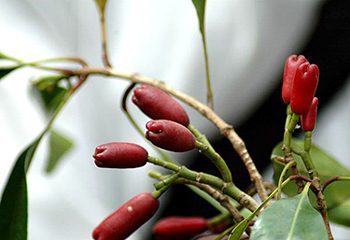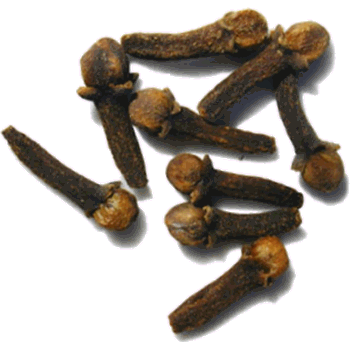Contents:
Common Names | Parts Usually Used | Plant(s) & Culture | Where Found | Medicinal Properties | Biochemical Information
Legends, Myths and Stories | Uses | Formulas or Dosages | How Sold | Warning | Resource Links | Bibliography
Scientific Names

- Caryophyllus aromaticus L.
- Syzygium aromaticum L.
- Myrtaceae
- Myrtle family
Common Names
- Ding-xiang (Chinese name)
- Lavanga (Sanskrit name)
- Ting-hsiang (Chinese name)
Parts Usually Used
Flower buds, dried
Back to Top

Description of Plant(s) and Culture
The clove is an evergreen tree, 15-30 feet tall; it has opposite, ovate leaves more than 5 inches long; and its flowers, when allowed to develop, are red and white, bell-shaped, and grow in terminal clusters. The familiar clove used in the kitchen is the dried flower bud. The fruit is a one-or two-seeded berry.
Back to Top
Where Found
Native to the Spice Islands and the Philippines but also grown in Sumatra, Jamaica, the West Indies, Brazil, and other tropical areas.
Back to Top
Medicinal Properties
Anodyne, antiemetic, antiseptic, anti-nauseous, aphrodisiac, carminative, stimulant
Back to Top
Biochemical Information
Clove oil is comprised of eugenol, caryophyllene, acetyl eugenol, tannin, wax and fat.
Back to Top
Legends, Myths and Stories
Cloves are actually the dried buds of the clove tree. Used in China for more than 2,000 years, legend has it that cloves are an aphrodisiac. Although there isn’t any evidence to back up this claim, we do know that oil of clove is a time-honored remedy for toothache.
Back to Top

Uses
Clove oil will stop the pain of a toothache when dropped into a cavity. A few drops of the oil in water will stop vomiting, and clove tea will relieve nausea. Eating cloves is said to be aphrodisiac.
It aids digestion, allays flatulence, nausea and/or vomiting, stops hiccoughs, and treats impotence. Used for colds, cough, asthma, hiccough, laryngitis, pharyngitis, low blood pressure. Cloves are mildly aphrodisiac. The volatile oil is a powerful analgesic.
The spicy, dried, unopened flower buds of the beautiful tropical evergreen clove tree uses:
- Whole cloves in stewed fruit, hot spiced drinks, pickling liquids, marinades;
- Ground spice in breads, cookies, spice cakes, pies, fruit dishes, curries, and some meat dishes.
Formulas or Dosages
Oil: for toothache, rub oil on affected area. For vomiting, mix 2 drops of oil in a cup of water.
Back to Top
How Sold
- Oil of Clove
- Ground or
powdered cloves
- Whole cloves
Warning
Avoid cloves in cases of hypertension and inflammatory conditions.
Back to Top
Resource Links
Herbs That are More Effective in Treating Lyme Than Antibiotics
LiveStrong.com: Clove Oil for Fleas
U.S. National Library of Medicine: Clove or Clove Oil
SimpleSteps.org: GreenPaws Flea and Tick Products Directory
The Green Spotlight: Flea and Tick Treatments That Won’t Poison Your Pet
University of Maryland Medical Center: Eugenol Oil Overdose
Bibliography
![]() The Herb Book
The Herb Book, by John Lust, Bantam Books, 666 Fifth Avenue, New York, NY. copyright 1974.
![]() The Complete Medicinal Herbal
The Complete Medicinal Herbal, by Penelope Ody, Dorling Kindersley, Inc, 232 Madison Avenue, New York, NY 10016, First American Edition, copyright 1993
![]() Indian Herbalogy of North America
Indian Herbalogy of North America, by Alma R. Hutchens, Shambala Publications, Inc., Horticultural Hall, 300 Massachusetts Avenue, Boston, Massachusetts 02115, 1973
![]() Chinese Medicinal Herbs
Chinese Medicinal Herbs, compiled by Shih-Chen Li, Georgetown Press, San Francisco, California, 1973.
 Earl Mindell’s Herb Bible
Earl Mindell’s Herb Bible, by Earl Mindell, R.Ph., Ph.D., Simon & Schuster/Fireside, Rockefeller Center 1230 Avenue of the Americas, New York, New York 10020
 Old Ways Rediscovered
Old Ways Rediscovered, by Clarence Meyer, Meyerbooks, publisher, PO Box 427, Glenwood, Illinois 60425, published from 1954, print 1988
Herbal Gardening, compiled by The Robison York State Herb Garden, Cornell Plantations, Matthaei Botanical Gardens of the University of Michigan, University of California Botanical Garden, Berkeley., Pantheon Books, Knopf Publishing Group, New York, 1994, first edition
![]() Planetary Herbology
Planetary Herbology, by Michael Tierra, C.A., N.D., O.M.D., Lotus Press, PO Box 325, Twin Lakes. WI 53181., Copyright 1988, published 1992
![]() Webster’s New World Dictionary
Webster’s New World Dictionary, Third College Edition, Victoria Neufeldt, Editor in Chief, New World Dictionaries: A Division of Simon & Schuster, Inc., 15 Columbus Circle, New York, NY 10023
 The Magic of Herbs in Daily Living
The Magic of Herbs in Daily Living, by Richard Lucas, Parker Publishing Co. (1988).
![]() The Herbalist Almanac
The Herbalist Almanac, by Clarence Meyer, Meyerbooks, publisher, PO Box 427, Glenwood, Illinois 60425, copyright 1988, fifth printing, 1994
![]() The Yoga of Herbs: An Ayurvedic Guide to Herbal Medicine
The Yoga of Herbs: An Ayurvedic Guide to Herbal Medicine, by Dr. David Frawley & Dr. Vasant Lad, Lotus Press, Twin Lakes, Wisconsin, Second edition, 1988.
 The Rodale Herb Book: How to Use, Grow, and Buy Nature’s Miracle Plants (An Organic gardening and farming book)
The Rodale Herb Book: How to Use, Grow, and Buy Nature’s Miracle Plants (An Organic gardening and farming book), edited by William H. Hylton, Rodale Press, Inc. Emmaus, PA, 18049., 1974


